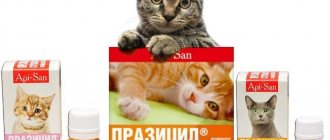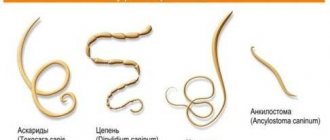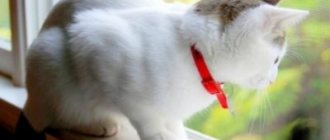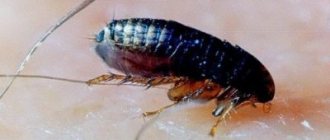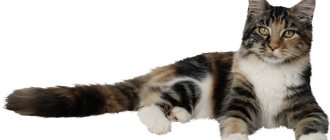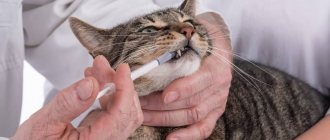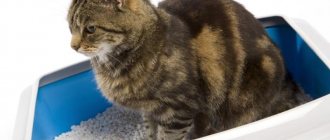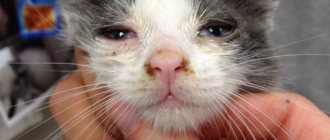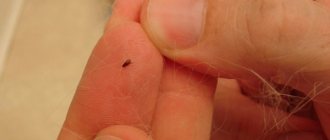Having a pet isn't always a happy occasion. If he is taken from unfavorable conditions or from the street, then he is most likely infected with various parasites. Without treatment, your small pet will become seriously ill or die. Removing fleas from a kitten is not so easy. Due to his age, he is very sensitive to insecticides, and they can cause poisoning.
Dealing with fleas on a small kitten is quite difficult.
Signs of fleas in a kitten
Signs that your cat has been attacked by fleas include:
- Frequent, almost constant scratching;
- Rubbing the sides or muzzle against furniture or other hard objects;
- Anxiety or, on the contrary, “sadness”;
- Poor health, sluggish appetite.
The cat’s coat will also reveal itself: scratches, bald patches, scabs from constant scratching of bites appear on it, and parasite eggs can be seen. Fleas on a kitten are visible even without a microscope; their brown elongated body cannot be confused with anything else.
Signs and routes of infection
Fleas are blood-sucking insects that carry infection. They have a flat body and strong, tenacious limbs, which allows them to move quickly in the animal's fur.
Fleas have a flat body and strong, prehensile limbs, which allows them to move quickly through the animal's fur.
There are types of fleas that can survive for up to a year and a half without the blood of their host animal. They are very tenacious and their strong, smooth shell prevents them from being easily crushed.
A fertilized female flea forcefully throws out eggs as she walks in small portions, then they roll off the host's fur. In an apartment, flea eggs can accumulate anywhere, so a kitten can pick up parasites in different ways:
- on the street;
- on carpet, bedding or upholstered furniture;
- on a person’s clothes and/or shoes;
- from adult cats and other pets;
- from mice and rats that kittens hunt.
A fertilized female flea forcefully throws out eggs as she walks in small portions, then they roll off the host’s fur.
No matter how fleas end up in your pet’s fur, it is important to quickly identify the signs and take measures to eliminate the parasites from the animal’s fur.
Fleas carry various pathogens that cause diseases in humans and animals, so if you notice signs of infection, immediately begin fighting the parasites.
You may not notice fleas right away, only if there is already a whole colony of them. To recognize them, just run your hand against the fur and you will see small dark insects on the kitten’s skin.
Characteristic signs of parasites appearing on your pet’s skin:
- the kitten is constantly itching and/or biting into the fur;
When a kitten has fleas, he begins to itch constantly - wounds and scratches appear on the skin that do not heal for a long time;
- the skin of the animal's neck and abdomen contains small black particles - flea excrement;
One of the signs that a kitten has fleas is small black particles in the fur - flea excrement. - in a neglected state, serious skin problems arise - dermatitis and dermatophiliasis (ulcerative skin lesions).
A flea-infested kitten may develop dermatitis
How a kitten got fleas
Even at home, you can’t be sure that kittens won’t have fleas. The main danger, and not only in terms of bloodsuckers, is the street. You can endlessly search for the answer to the question of how to get rid of fleas from a kitten; self-walking will nullify all efforts. But even if animals do not leave the house, kittens can develop ectoparasites. The risk is especially high:
- On the first floors of a private or multi-storey building, where cats often sneak into and where there are entrances to the basement, fleas come from there;
- When meeting someone else's infected cat;
- At exhibitions;
- At a party where there are other animals;
- In veterinary clinics.
A kitten can get sick, even if it has not had time to visit anywhere - domestic cats also infect their offspring.
To imagine the scale of the problem for cats, it is enough to know what kind of insects they are. A female flea lays up to two thousand eggs throughout her life. Fleas are jumping and elusive. It is enough for an adult insect, larva, or imago to be close to the kitten for infection to occur. Fleas multiply very quickly and soon the cat's coat will be infested with parasites.
Danger of flea infestation
Fleas are blood-sucking parasites that cause a lot of trouble for pets and their owners. Insect infestation is dangerous even for healthy adult animals, let alone small kittens.
Life activity of fleas in a kitten:
- provokes severe itching and irritation of delicate skin;
- lead to local and widespread hair loss;
- causes allergic dermatitis in kittens (skin reactions to insect saliva and feces);
- causes anemia;
- poses a risk of helminth infection.
Even a domestic cat that never goes outside can be attacked by fleas, because these parasites are able to travel long distances in search of a new victim. The owner, without knowing it, can bring eggs and insect larvae into the house along with outdoor shoes and clothing.
One flea caught on an animal can lay up to 300 eggs in two weeks, and if the owner misses this moment, a cat infected during pregnancy and lactation will certainly pass on the parasites to all of its offspring. A weak newborn kitten infected with fleas may die if there is no quick and qualified human assistance.
How to rid a kitten of fleas
It is more difficult to cope with the problem using folk remedies if there is more than one kitten in the house. It's not just about the risk of re-infection. The main difficulty in removing bloodsuckers is the limited possibilities of using flea control drugs. Almost all special drugs are poisonous. Usually, kittens are washed with shampoo or treated with another disinfectant from a veterinary pharmacy. Insecticides cause no less harm to cats than fleas themselves, even to adult cats. The danger for the fragile immunity of children is even higher. The question of how to remove fleas must be resolved with the participation of a veterinarian. Not only the age of the kittens matters, but also the general state of health and the degree of susceptibility.
If all the symptoms are present that the kittens have unpleasant neighbors, you need to find a way to get rid of fleas as quickly as possible. You can’t expect that the fleas will go away on their own or wait until the cat grows up to “killer” products, but a small one can be patient. It's a delusion. Bloodsuckers are dangerous for a kitten; they literally eat it alive. Constant bites nullify natural immunity, interfere with play and normal development.
Bathing and mechanical fighting method
After treating the mother cat, you should start cleaning the sleeping area of the cat family. The bedding and soft bed must be washed at a temperature of 60-90 degrees (in winter, when it is frosty, you can take the house out into the cold), cat combs should be doused with boiling water. It wouldn't hurt to do a thorough cleaning of the entire house.
If all the measures taken did not give the desired result, and it was not possible to completely get rid of fleas, you can start bathing the babies. However, it should be remembered that newborn kittens should be washed with extreme caution, in a warm room where there are no drafts.
The following is used as an insecticide when bathing:
- foam of tar or baby soap;
- a weak soap solution with anti-flea shampoo for kittens;
- decoction of Persian chamomile, tansy or wormwood.
The babies are carefully dipped into warm water and the detergent is rubbed into the fur with light movements, avoiding getting foam on the face. The procedure should be performed quickly so that the animals do not catch a cold. In case of heavy infection, leave the cleaning composition on the kittens for about a minute, then wash off. After bathing, the kittens are dried or dried with a hair dryer, placed on a heating pad until completely dry, and then returned to the cat.
One of the safest ways to rid newborn kittens of fleas is combing. The fur of small furry cats is not as thick as that of adult cats, so parasites are visible to the naked eye. For the procedure you should prepare:
- a bowl of water;
- a special comb with fine teeth to combat head lice (sold at the pharmacy).
The baby should be thoroughly combed, held over a bowl of water so that caught insects fall into it. The procedure must be repeated several times. This method is devoid of any contraindications or side effects, therefore it is absolutely safe for newborn kittens.
At what age can babies be treated with veterinary insecticides? The safest product is recommended to be applied no earlier than kittens are 8 weeks old. Fleas should be poisoned in animals with weak immune systems no earlier than they are 6 months old. In this case, kittens must be separated from their mother.
Traditional methods
So, the question is: what to do if a kitten has parasites and how to remove them. The main thing is to be patient. If a very small kitten, less than two months old, is infected, getting rid of the parasites will take longer. Chemicals, such as special shampoos and weak flea drops, will be needed no earlier than 2 months. Stronger insecticidal compounds - from six months.
This is especially true for drugs that have dichlorvos, permethrin or malathion in the annotation. Fleas die immediately from these compounds, but children should not use them. Gentle natural methods, such as herbal baths, are suitable for kittens. This is the most effective folk remedy, but it can only clean the fur and temporarily drive away most of the parasites. It will not be possible to eliminate them forever without the help of flea drops and other “chemicals”.
In the question of how to remove fleas from a nursing cat, there are no such strict prohibitions as for kittens. For those who are heavily infected, for example, the drug Stronghold is suitable. It is enough to treat your cat once so that fleas no longer bother her.
Combing
The mechanical method of removing bloodsuckers from kittens at home is the safest and weakest at the same time. It is better to immediately understand that this is a temporary measure that will have to be repeated more than once in order to get rid of fleas.
The kitten is placed over a sheet of white paper, the fur is combed out with a stiff and frequent plastic comb with rounded teeth. You can purchase a special scratcher for kittens. First comb the back, moving to the sides and tummy, paws. On average, one combing session takes about ten minutes.
It is better not to touch the kitten's head, so as not to injure the eyes and other delicate areas. It is better to immediately shake off falling fleas into the toilet or a bowl of water. The comb is cleaned of collected hair and parasites.
The procedure is repeated twice a day until the fleas completely stop bothering the cat (usually this takes about a month). But even then you will have to regularly check the coat: you won’t be able to comb out all the clutches, and new fleas will develop from the remaining ones.
Bathing
To get rid of fleas, just bathe the kitten in a weak solution of salt or herbs. It is often recommended to wash with baby soap. The advice is harmless and useless. Baby soap is suitable for one use if the kitten has just been picked up from the street; it is powerless against fleas. With repeated washing, the hairs become tangled, lose their shine, and the risk of an allergic reaction increases.
- Salt bath. Neither the kitten nor the fleas will suffer from it - at least during one bath. Pour table salt into warm water in the proportion of one tablespoon per 200 ml and dissolve. The kitten is placed in a bowl of solution for about ten minutes. After the procedure, the fur coat is dried with a towel and combed out. The procedure is repeated weekly.
- A bath with a decoction of wormwood or tansy - fleas especially do not like these herbs. The herb is crushed and brewed in boiling water - a tablespoon per glass. The infusion is poured into the bath and cooled to a temperature comfortable for the baby. The kitten is placed in the solution for five to ten minutes, dried and combed.
You can repeat bathing several times a week. After washing, the fur must be thoroughly dried and ensure that the pet is not near an open window. There are different opinions regarding whether it is possible to blow-dry a kitten after removing fleas. There is a high risk that artificial drying will disrupt heat exchange or frighten the kitten. You can safely use a hairdryer on an adult cat after bathing if he is comfortable with technology and has become accustomed to it since childhood.
Tar soap
The most difficult thing is to find a way to properly get rid of fleas from a kitten if the owner is only inclined to use “folk remedies” and does not accept “chemicals”. The solution is tar soap. It can be used from the age of one month. The block is rubbed on a grater. The shavings are foamed to a thick foam, applied to the wool and rubbed gently. After a few minutes, wash off and dry the fur coat. Dead parasites and eggs are combed out with a fine comb. Usually a couple of baths are enough for fleas to stop reminding you of themselves.
Tar soap is not suitable for newborn kittens. It will not be possible to rinse the detergent completely out of wool, even without saving water.
Treatment of mother cat for fleas
Any antiparasitic treatment of an animal is a burden on the body. Newborn kittens are extremely sensitive to any veterinary flea medications, and most chemicals are prohibited for use until the babies reach a certain age. Failure to comply with this rule can lead to poisoning not only of the babies themselves, but also of their mother. The cat constantly licks its offspring; therefore, everything that is applied to the babies’ fur will end up in its digestive tract, blood and milk. However, you cannot delay treatment, since anemia caused by fleas can claim the lives of all kittens in a matter of days.
The degree of flea infestation can be reduced by treating the cat with veterinary drugs approved for use in lactating animals. Even if a certain number of insects survive, they will not cause much harm to normally developing kittens.
A half-measure in the form of treating a nursing cat will minimize the harm from fleas to newborns for the period until the kittens reach the age at which they can be treated.
Veterinary drugs approved for use in nursing cats:
- Drops on the withers Advantage (Advantage) 40. A reliable and safe insecticide for external use, which has an “umbrella effect” (when treating a nursing cat, the litter also receives protection). The main active ingredient is imidacloprid. The drug does not affect the central nervous system of mammals. Apply directly to the skin, in a place that the cat cannot lick (between the shoulder blades).
- Frontline Combo drops for cats. A fast-acting remedy with a long-lasting effect. The active ingredients are fipronil and S-methoprene. The drug is safe to use in pregnant and lactating females. Apply to the withers.
- Drops against fleas and ticks Beaphar (Beafar). Natural parasite repellent. The active ingredient is an extract from the Neem (Margosa) tree. Safe drug without side effects.
Special means
The question of how to remove fleas from kittens, if only conservative means are available, is difficult to resolve. Especially if the pet has already become familiar with the street. If a kitten has fleas over two months of age and the cat no longer feeds it, you can try some chemical compounds with caution, with the permission of a veterinarian. This also applies to adult cats. For the first procedure, a small dose of the drug is used to assess the body's reaction.
Kittens from 2 months old can be washed with tar or laundry soap once a month so as not to catch a cold or damage their fur. Fur is a self-cleaning system; water is used only when extremely dirty. If a conservative remedy does not help in the fight against fleas, it is better to choose a stronger one. The main thing is that it is safe.
Shampoos
The most affordable, popular and relatively harmless means for getting rid of fleas at home are plant-based or chemical-based shampoos. They may contain plant extracts and synthetic insecticides, so you should look at the composition before purchasing. The shampoo can be used to remove fleas from the age of two months. The kitten needs to be seated in a basin and foamed shampoo should be applied to its fur, starting from the back. Rinse thoroughly so that the kitten's head does not fall under the water.
After washing, the coat must be dried and combed.
Drops and sprays
Many arguments can be made against chemistry, but fleas cannot be eradicated using gentle methods. Quick and effective remedies for fleas on kittens are poisonous. They can only be used when the pet reaches a certain age, after weaning from its mother. You should not poison fleas immediately after vaccination or if the kitten is not feeling well.
- Flea drops are poisonous to insects and their “carriers”.
- Sprays. They are sprayed onto the fur coat, without rinsing. Fleas usually go away after the first or second application.
- Powder. Effectively gets rid of fleas and is practically harmless. It is poured onto the withers and then evenly distributed over the fur; there is also no need to rinse it off. The hairs become stiffer after using it.
- Solutions. A concentrated flea remedy is dissolved in water in the required proportion and applied to the kitten’s fur. Most of them are indelible and do not require combing. To get rid of bloodsuckers completely, a single procedure is usually enough.
Chemical flea compounds for kittens are also quite dangerous and are suitable starting from the kitten’s adolescence - about six months. You should resort to a strong drug if softer ones do not give results. When washing, some part of the substance will inevitably enter the kitten’s body and can cause harm to its health.
Collars
Contrary to popular belief, using a collar will not immediately get rid of fleas. This is not the best or most effective remedy for eliminating fleas on a small kitten. Especially if there are a lot of them. The collar only helps against re-infestation with fleas. It is worn after shampoo or drops, treatment with Bars spray. Most collars are strong and are only suitable for older kittens, from six months of age. Some flea remedies are used from eight months and even from a year.
Accessories soaked in poison are by no means harmless:
- They rub the skin on the neck of kittens, causing bald spots and abrasions;
- Any flea collar is poisonous. Each drug requires a different time to be eliminated from the body. An adult cat can easily get used to a collar; kittens have a higher risk of intolerance.
- May provoke an allergic reaction;
- The kitten will try to tear off the collar with its claws. This is fraught not only with the fact that he will scratch himself, but also with the substances with which the collar is impregnated getting into his stomach.
- The collar should not be worn on a pregnant or nursing cat. There are gentle drops for them.
Before removing parasites, you should carefully read the instructions for the collar. Particular attention is paid to the age at which its use is allowed.
The kitten may try to rip off the collar at first. This is normal: the animal wants to remove an unusual object. He'll soon get used to it. If the protest is accompanied by lethargy, deterioration in health, or vomiting, the collar should be removed immediately and an alternative discussed with the veterinarian.
It is important to remember that all developers focus primarily on the health of pets. Not a single drug, be it drops, shampoo or collar, will give an instant result - especially if there are other kittens in the house or the animal has been to the clinic or at the dacha. Complete relief from fleas occurs only after systematic use.
Pills
Flea remedies for kittens in the form of tablets appeared in veterinary pharmacies recently and quickly became popular. They are prescribed even to babies under 6 months, when all gentle anti-flea drugs are useless. The dose is calculated, in the same way as in the treatment of worms, based on the weight of the animal. The blood of a kitten that takes the pill will turn into poison for a month. It is enough for a flea to attach itself and it will die.
Treatment with tablets is more effective and even safer than folk remedies, shampoo or treatment. Most of the active substance will be eliminated from the body after 48 hours. Complete removal of the flea medication usually occurs within a week and a half.
Flea tablets are suitable for kittens from two months of age
Ways to combat parasites in kittens of different ages
When choosing a suitable remedy, you need to take into account the age of the kitten so as not to harm it with treatment.
In a newborn kitten
Treating a newborn baby with any antiparasitic drugs is strictly prohibited. You must wait until the kitten is at least 4 weeks old. In the meantime, treating a kitten is problematic, you can alleviate its condition with the following measures:
- thoroughly vacuum the room;
- wash or change the bedding;
- comb your pet or try to catch insects with your hands.
It is advisable to comb the kitten every day, using a fine-toothed comb.
In kittens up to 1 month
Fleas can be removed from a kitten under 1 month of age only by combing. All other methods for a small pet will be too aggressive and may do more harm than good. As the pet gets older, the owner will have more and more options available to him on how to rid him of fleas. For example, a one-month-old kitten can already be bathed with anti-flea shampoo. The main thing is to make sure that the product is suitable for his age.
In kittens up to 2 months
The list of flea remedies for kittens aged 1 to 2 months is replenished with some types of anti-parasitic shampoos. In addition, at 1.5 - 2 months, some types of drops can already be used.
You can rid a kitten of fleas using drops only after it has been weaned from its mother. Otherwise, the cat may lick the medicine, which will then enter the baby’s body with the milk, causing poisoning, and it is unlikely to benefit the mother. Some types of biocollars are designed to protect two-month-old kittens from fleas, but they are rather weak for treatment.
In kittens after 2 months
The arsenal of means for removing fleas from kittens older than 2 months is expanding significantly. In the third month of life, you can fight parasites with the help of shampoos, drops, and some types of sprays. At this age, traditional methods can also be used to get rid of fleas.
What you should never do
Before you buy flea products for kittens, remember the “don’ts”:
- treat with an insecticide if the animal is just after vaccination, is unwell or does not feel well;
- use untested products or those where the age is not indicated in the instructions;
- apply the drug without testing it for susceptibility;
- put collars on kittens, apply shampoos, aerosols, powders for adult cats;
- Wash kittens often with anything - even with heavy soiling, it is usually enough to wash their paws.
Anything that has not been approved by a veterinarian for getting rid of fleas at home is prohibited. Even before bathing a kitten in a decoction of herbs, without chemicals or drops, consulting a doctor will not hurt.
Selecting products based on breed
It is also important when choosing a medicine to consider what breed your pet is.
- owners of fur coats with long, thick hair of breeds: Persian, Himalayan, British, Maine Coon and others are more suitable for using shampoos;
- It is recommended to treat smooth-haired beauties with drops and sprays. Of particular note is the Sphynx breed. After all, at first glance it may seem that they cannot have fleas, but this is far from the case. You can detect the presence of parasites in a kitten of this breed in this way: rub its back on a clean white towel. If you find reddish-brown spots, then know that your pet is infected with parasites.
Injections are recommended only as a last resort - if the above methods do not help. The vaccine injection must be carried out by a specialist. Doing this yourself at home is not recommended.
To carry out treatment using all of the above methods, you must strictly observe the proportions in order to avoid poisoning the pet.
Main signs of poisoning:
- pain and discomfort in the abdominal area;
- excited state;
- in other cases lethargy;
- nausea, vomiting, diarrhea;
- in severe cases, blindness, damage to the central nervous system: paralysis, convulsions;
- increased heart rate and breathing.
First aid methods for poisoning:
- pour a weak solution of potassium permanganate into the kitten’s mouth;
- You can use a salt solution: one teaspoon per glass of water. The baby needs 10-20 ml at a time;
- activated charcoal helps - it needs to be dissolved in water 1:1 and given to the kitten;
- You can try putting a little baking soda on the tip of the animal's tongue.
Prevention
Small kittens are rid of bloodsuckers in different ways, with varying degrees of success. Even widely advertised anti-flea collars, sprays or drops for kittens do not provide an exact guarantee. An effective way to combat any disease is prevention. This also applies to parasites. If you monitor the health and cleanliness of your cat from the first day of life, the question of how to get rid of fleas arises less often and on a smaller scale. Another thing is former street pets. It is better to eradicate ectoparasites before pregnancy. After this, you will have to carefully monitor the cleanliness of the room where the expectant mother is in order to prevent fleas from appearing again.
Preventive recommendations
Treatment is always more difficult and more expensive than prevention. To prevent the infection from reoccurring, try to follow simple recommendations:
- Keep the area where your pet is kept clean;
- do regular examinations of your pet for the presence of parasites;
- exclude the kitten from contact with homeless animals.
Fighting fleas on a pet is a long and burdensome task, so be sure to have love and patience. Let your kitten be healthy and active without parasites and negative consequences from their appearance!
Finding fleas on newborn kittens is extremely unpleasant. However, aesthetic discomfort from seeing parasitic insects on your pet and her offspring is only a small part of the problem. After all, flea infestation poses a huge threat to the health of small fluffy balls that have just been born. That is why it is necessary to take all possible measures as soon as possible to completely exterminate fleas in kittens and prevent repeated attacks by insects.
Symptoms of flea infestation
Small blood-sucking insects look like black grains up to 2 mm long. They move by jumping, sucking blood from the animal, piercing the skin. It is enough for one flea to get on the fur of an animal, and the active process of its reproduction begins.
Kitten in the house
When fleas appear, the pet begins to behave restlessly, itches, and tries to get rid of the insects with its teeth. As a result, wounds form on the skin.
It is not difficult to find fleas on the body. When you part the fur, you can see black moving dots, droplets of dried blood, dark fecal grains and eggs that look like salt particles.
The largest concentrations of fleas gather in the tail area and on the lower back. When infected with fleas, a kitten will experience:
- itching;
- restless behavior;
- scratching the skin:
- swelling of the epidermis;
- dermatitis;
- hair loss;
- weight loss.
Folk remedies that remove fleas from baby cats
Among the folk methods of effectively combating annoying fleas are:
- sagebrush. You can use a decoction of plants to wash the fur of kittens or lay out branches of the plant on the floor of the apartment;
- combing with a thick comb (but in this way it will not be possible to completely rid the animal of parasites);
- pine sawdust. The blocks do not tolerate the smell of pine, so sawdust can be placed under the animal’s rug and spread on the floor in the apartment;
- a mixture of soda and salt. Sprinkle the powder on the carpets in the apartment, and after 4 hours vacuum them;
- tar soap. Lather the fur of a 2-month-old kitten for 5 minutes, then rinse with warm water.
Review of popular flea drops - application, indications and contraindications
To understand which flea drops to choose, it makes sense to analyze the best ones.
Inspector
This drug will help cure a kitten from fleas, ticks, and lice. The number of drops depends on the actual weight of the animal and is determined according to the table given in the instructions.
A contraindication for use is individual intolerance to the components of the drug.
Celandine
The drug is recommended for cats and kittens who are already 2 months old. Apply to dry skin at the withers and between the shoulder blades. One pipette with medicine is designed for a cat weighing 2-10 kg.
Drops Celandine
The drug should not be used in kittens under 8 weeks of age if they have an allergic reaction to its components or with a weakened immune system.
Advantage
With the help of these drops it will be possible to rid cats and kittens of lice, fleas and lice. The product should be applied to the withers, the dosage is determined by the weight of the pet. The result comes within 12 hours. The drug can be used to treat domestic kittens at any age. It is also allowed for pregnant and lactating cats. There are no contraindications.
Stronghold
Drops are prescribed to cats and kittens once from 6 weeks of age in the presence of fleas, ticks and helminths. The amount of product is calculated based on the weight of the animal, the effect occurs within 2 hours. Repeated use of the product will need to be done once a month.
The drug is prescribed to remove fleas, lice and lice from the fur of a four-legged pet. It is used once in the form of drops, applied in the withers area, between the shoulder blades (in hard-to-reach places that cannot be licked off). The dosage depends on the weight of the animal and is determined according to the table located in the instructions.
Contraindications include intolerance to the components of the product, the presence of infectious diseases, age up to 8 months, weight up to 2 kg.
Beaphar
Drops are recommended for repelling fleas and other parasites, starting from 12 weeks of age in kittens. The product should be applied to the withers. The effect is observed for 1 month, after which the procedure will need to be repeated.
How to get rid of it with bathing?
If a kitten is found to have fleas, you should bathe it using parasite-control shampoos.
Cats do not like water, and this is a serious test for them, so it is important to follow the correct algorithm:
- First, trim your pet's nails to prevent him from scratching you.
- Make sure there are no drafts and that the room is warm enough, as cats get very cold during bathing.
- Prepare a basin or bath, the shampoo itself, a comb for combing and a towel.
- Gently and carefully place the kitten in a bowl of water, stroking the animal. The temperature should be 38–42 degrees.
- Calmly wash the animal from head to toe. To prevent water from getting into your ears, insert cotton swabs into them. Apply a drop of Vaseline to the teardrops of your eyes.
- After the fur is wet, diluted shampoo is applied to the animal's paws and body. You need to foam it thoroughly and leave it for 7-8 minutes.
- Rinse the kitten under running water. Rinse off the shampoo thoroughly for 5–7 minutes. Otherwise, the animal may become poisoned by licking its fur in the future.
- After washing, wrap the cat in a towel. Start combing out the parasites with a comb. They are usually very visible on wet wool.
- At the end, wipe, dry and pet the baby who has experienced serious stress.
Fleas cause a lot of inconvenience to animals. Modern tools make it possible to deal with them quickly and effectively. If we are talking about a kitten, choose medications carefully, taking into account age restrictions.
Removing fleas with sprays
The kitten should be treated with the spray after a good feeding. The baby should hold his head so that he does not accidentally expose it to the spray of the drug, carefully part the fur and spray the exposed areas of the skin.
Care should be taken to ensure that the spray does not get into the baby’s eyes. After treatment, you should play with the kitten for half an hour or an hour, and then immediately bathe it.
One of the optimal flea sprays for kittens is Beaphar spray, which provides reliable removal of parasites at a reasonable price.
Hartz and Frontline sprays are also good, but only for kittens from the age indicated in the instructions for their use.
Review
“The easiest way to treat a kitten for fleas is with a spray. This spray costs a little more than the drops, but gives an almost instant result - the fleas either die on the kitten or jump off it. We sprayed our miracle with Hearts, there were no problems from it, the fleas disappeared immediately ... "
Irina, Moscow
What should you do if your kitten is poisoned by flea medication?
In rare cases, a kitten may accidentally swallow flea drops or lick shampoo or powder from its fur. In most cases, this does not lead to serious consequences, but sometimes the baby develops allergies, vomiting, drooling, anxiety, shortness of breath, discharge from the nose and eyes, as well as other signs of intoxication. If you think your kitten has been poisoned by flea drops, give him plenty of water or milk and show him to the vet as soon as possible. First, the drops themselves can be wiped off from the kitten’s skin using a cotton swab with vegetable oil.
And finally, if the kitten’s fleas have been successfully removed, all that remains is to consolidate the result. The first thing is to buy anthelmintic drugs and treat the baby’s helminths. The second is to look for fleas in the apartment, and if they are found, remove them in any way, including treating the entire room for fleas. In the future, the kitten should buy a special “children’s” flea collar and be allowed outside only wearing it.
This way the baby will certainly be protected from fleas in the future.

